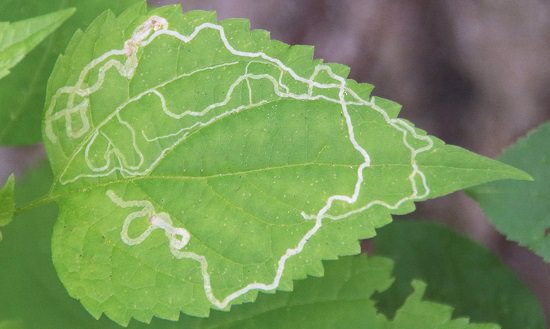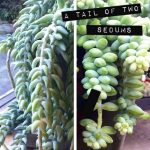Leaf miners can cause a lot of damage to your plants, check this article to learn How To Identify and Control Leaf Miners!
Have you ever heard of or seen a pest called “leaf miners?” You can identify their damage by spotting the light-colored squiggly path they leave on the surface of new leaves. Inside the light colored path is a thread of something. You know what that thread is? Poop. Or to be more science-y, entomologists call insect poop “frass.” Yep. The larvae of several different insects (mostly moths, sawflies, and flies) burrow into the soft tissue of young leaves and start eating their way all around the leaf. What goes in one end comes out the other as that thread of frass.
You can usually identify which insect is doing the damage by the type of plant being eaten. The photo above is of a tangerine tree, so the likely culprit is Citrus Leafminer, (Phyllocnistis citrella). Luckily even heavy citrus leaf miner damage doesn’t impact fruit production in California-grown citrus (though in areas where bacterial canker are present, leaf miner damage presents an opportunity for bacterial canker).
Lemon trees growing in very mild climates (coastal areas in CA) are the one exception to the rule that leaf miners don’t reduce citrus fruit production. According to the Center for Invasive Species Research, “Coastal lemons have continuous flushing of leaves and produce multiple crops of fruit. The continuous flushing allows prolonged infestations of CLM that reduce the vigor of trees and fruit production.”
Leaf miners aren’t limited to citrus trees. I’ve seen them in squash plants, chard, lettuce, tomatoes, and in ornamental plants too. Obviously, leaf miners are the most damaging to food crops where you eat the leaves. Who wants to eat a salad full of lettuce impregnated with maggots and their frass? Please don’t invite me to that harvest dinner!
How to Manage Leaf Miners
If you’ve had leaf miner damage in the past, it’s probably best to be proactive. To protect small seedlings from leaf miners (when extensive damage could kill the plant), cover them with a protective cloth. Buy something called a “floating row cover” from your garden center and drape it completely over your plants. Use stakes or other caging to keep the row cover from smothering the plants. The row cover will also benefit your plants by increasing the humidity, which most plants like.
As soon as your plants can tolerate some damage, remove the row cover. When you see leaf miner damage on crops where you eat the leaves, snip the leaves off and throw them in the trash. Most plants whose crop is not their leaves can sustain some leaf miner damage, so it is best just to leave the damaged leaves alone. Chemical or organic sprays do not effectively control leaf miners, so it is best not to try. Their populations are often kept in check by tiny beneficial wasps that like to parasitize leaf miners. When you spray indiscriminately–or worse, when it is not even beneficial–you risk killing off the beneficial insects that are keeping pests under control in the old fashioned way (by eating them!).
Have you had leaf miners in your garden? What were they eating, and how did you solve the problem?



